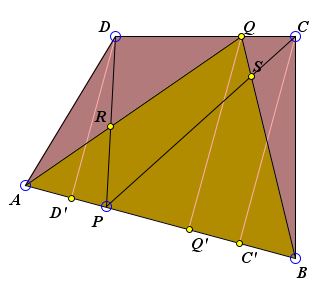Carpets in a Quadrilateral
Points P and Q are located on the sides AB and CD of a convex quadrilateral ABCD so that
|Activities| |Contact| |Front page| |Contents| |Geometry|
Copyright © 1996-2018 Alexander BogomolnyThis is problem #136 from a problem collection by Barbeau, M. S. Klamkin, W. O. J. Moser. The Carpets Theorem is not mentioned in the book and in fact is not needed in the proof. If anything, the proof supplies an additional demonstration for the most general form of the Carpets Theorem.

Denote the common ratio
| (1) |
P = rB + (1 - r)A and Q = rD + (1 - r)C. |
Drop perpendiculars CC', QQ' and DD' from C, Q and D to AB and denote their lengths c, q, and d, respectively. Then
q = rd + (1 - r)c.
Now,
Area(ADP) = AP·d / 2 = r·d·AB / 2
Area(BCP) = BP·c / 2 = (1 - r)·c·AB / 2
Area(AQB) = AB·q / 2 = r·d·AB / 2 + (1 - r)·c·AB / 2,
so that obviously
| (2) | Area(AQB) = Area(ADP) + Area(BCP). |
If we denote AQB as S1 and CPD as T1, we'll find that the most general form of the carpets is directly applicable in our case because of (2) which simply states that
Area(S1) = Area(T2).
The required conclusion follows immediately. However, note that the same result is obtained by subtracting from both sides of (2) the areas of triangles APR and BPS.
References
- E. J. Barbeau, M. S. Klamkin, W. O. J. Moser, Five Hundred Mathematical Challenges, MAA, 1995, #136
Carpets Theorem
- The Carpets Theorem
- Carpets in a Parallelogram
- Carpets in a Quadrilateral
- Carpets in a Quadrilateral II
- Square Root of 2 is Irrational
- Carpets Theorem With Parallelograms
- Two Rectangles in a Rectangle
- Bisection of Yin and Yang
- Carpets in Hexagon
- Round Carpets
- A Property of Semicircles
- Carpets in Triangle
- Carpets in Triangle, II
- Carpets in Right Triangle
- Piecewise Carpets in Parallelogram
|Activities| |Contact| |Front page| |Contents| |Geometry|
Copyright © 1996-2018 Alexander Bogomolny73564102
